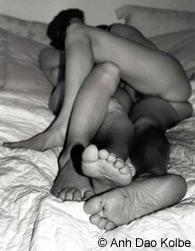"I'm not surprised by the results, because a woman's sexuality is often more fluid than a man's," said Dr. Stephen Goldstone, Medical Director of GayHealth.com. "But I think this also reflects positively on the younger generation's greater willingness to accept gay rights and gay marriage, and will hopefully translate into less homophobia in our society."

The trend among college women has prompted some sexual behavior experts to light-heartedly refer to the term "LUG," or "lesbian until graduation," said Craig Kinsley, a neuroscientist at the University of Richmond who studies the biology of sexual orientation and gender.
For women in their late teens and 20s, the percentage rose to 14 percent in the more recent survey. About 6 percent of men in their teens and 20s said they'd had at least one same-sex encounter.
While those who conducted the survey took measures to protect respondents' privacy, researchers say it's unclear whether the figure for men was lower because they're are more likely to avoid same-sex experiences or whether they're not reporting them.
The findings on bisexuality and other aspects of Americans' sexual habits were taken from the National Survey of Family Growth, which included 12,571 in-person interviews, done from March 2002 to March 2003. Overall, researchers said the report shows that most people have relatively few partners and are at a low risk for sexually transmitted diseases.
"Instead of just anecdotes and stories that raise people's anxieties, I think it's best to have real numbers," said William Mosher, the statistician who oversaw the report. "And now we have those."
When it comes to women and same-sex relationships, Mosher said it would be worth studying why young women seek such relationships, and whether they may be trying to avoid diseases more commonly spread through sex with men.
But some experts who study sexuality say it's even more likely that many college students simply see experimentation as a rite of passage.
"It's very safe in the academic community; no one thinks anything of it," said Elayne Rapping, a professor of American studies at the University of Buffalo who has written about sexuality.
"But to some extent there's more talk than action," she added, noting that the bisexuality label has become a "badge of courage" for some college women, even those who only date men. Meanwhile, she said, men who have same-sex experiences are often less likely to talk about it publicly.
The trend among college women has prompted some sexual behavior experts to light-heartedly refer to the term "LUG," or "lesbian until graduation," said Craig Kinsley, a neuroscientist at the University of Richmond who studies the biology of sexual orientation and gender.
In other findings, the survey said that about 10 percent of females, ages 15 to 19, and 12 percent of males had experienced heterosexual oral sex but not vaginal intercourse. While no earlier data were available for young women, percentages for young men in 1992 were about the same, researchers said.
Those numbers dropped substantially for people in their 20s, who were more likely to have had vaginal intercourse.
The survey also revealed that 39 percent of men, ages 15 to 44, who'd had at least one sexual partner in the last year said they used a condom during their most recent sexual encounter. That figure rose to 65 percent for men who'd never been married - and 91 percent for men who'd ever had sexual contact with another man.
Mosher said it was likely that men in higher-risk categories were heeding campaigns that encourage them to use condoms.
"Whether the levels (of condom use) are high enough is for others to judge," Mosher said. "But I think it's at least encouraging."
The survey of adults has a margin of error of 1 percentage point and 3 percentage points for the teen data.











 ÕłŚÕŹ░ńēłµ£¼
ÕłŚÕŹ░ńēłµ£¼










Ķ«ĆĶĆģÕø×µćē
µÉČÕģłńÖ╝ĶĪ©ń¼¼õĖĆÕĆŗÕø×µćēÕɦ’╝ü
Ķ½ŗÕģłńÖ╗ÕģźÕåŹõĮ┐ńö©µŁżÕŖ¤ĶāĮŃĆé